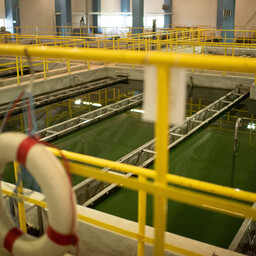Reoveepuhastamisel tekib palju setteid. Eestis
kasutatakse neid väetisena
. See on selleks reguleeritud, et
kaitsta keskkonda ja inimesi
.
kasutatakse neid väetisena
Tõlge fraasile: kasutatakse neid väetisena
EN
they are used as fertilizer
kaitsta keskkonda ja inimesi
Tõlge fraasile: kaitsta keskkonda ja inimesi
EN
to protect the environment and people
Margit Heinlaan uuris kolleegidega, kui palju mikroplasti on reoveepuhastusjaamade vees. Mikroplast on väiksed plastitükid, mis ei lahustu vees. Uuringus vaadati kuut erinevat puhastusjaama.
Uuringu tulemused näitasid, et puhastusjaamad eemaldavad veest 99,6–99,8% plastiosakesi. See on väga hea tulemus. Kuid heitvees on ikkagi väikesed kogused mikroplasti.
Mikroplast jõuab puhastatud veest reoveesettesse. Eestis ei põletata seda, vaid
kasutatakse haljastuses ja põllumajanduses
. Seega jõuab plast loodusesse.
kasutatakse haljastuses ja põllumajanduses
Tõlge fraasile: kasutatakse haljastuses ja põllumajanduses
EN
used in landscaping and agriculture
Heinlaan ja tema meeskond
teevad praegu uusi analüüse
, et määrata reoveesettides olevat mikroplasti ja muid aineid. Nad proovivad leida viise, kuidas mikroplasti hulka vähendada.
teevad praegu uusi analüüse
Tõlge fraasile: teevad praegu uusi analüüse
EN
are currently conducting new analyses
Plast võib mureda väiksemateks osakesteks. Plast sisaldab palju erinevaid aineid. Nende
mõju loodusele ja tervisele on veel teadmata
.
mõju loodusele ja tervisele on veel teadmata
Tõlge fraasile: mõju loodusele ja tervisele on veel teadmata
EN
the impact on nature and health is still unknown
Mikroplasti võib leida ka
majade tolmust ja linnatänavatelt
. Seda on raske täielikult vältida. Kuigi põllumajanduses kasutatavad plastiosakesed ei mõjuta toidu ohutust, tuleb
mikroplasti kogunemist pinnasesse piirata
.
majade tolmust ja linnatänavatelt
Tõlge fraasile: majade tolmust ja linnatänavatelt
EN
from house dust and city streets
mikroplasti kogunemist pinnasesse piirata
Tõlge fraasile: mikroplasti kogunemist pinnasesse piirata
EN
limit the accumulation of microplastics in the soil
A lot of sludge is generated during wastewater treatment. In Estonia, it is used as fertilizer. This is regulated to protect the environment and people.
Margit Heinlaan and her colleagues investigated how much microplastic is in the water of wastewater treatment plants. Microplastics are small pieces of plastic that do not dissolve in water. The study looked at six different treatment plants.
The study results showed that treatment plants remove 99.6–99.8% of plastic particles from water. This is a very good result. However, there are still small amounts of microplastics in the effluent.
Microplastics end up in the sewage sludge from the treated water. In Estonia, it is not incinerated but used in landscaping and agriculture. Thus, plastic enters nature.
Heinlaan and her team are currently conducting new analyses to determine the microplastics and other substances in sewage sludge. They are trying to find ways to reduce the amount of microplastics.
Plastic can break down into smaller particles. Plastic contains many different substances. Their impact on nature and health is still unknown.
Microplastics can also be found in house dust and city streets. It is difficult to completely avoid it. Although the plastic particles used in agriculture do not affect food safety, the accumulation of microplastics in the soil needs to be limited.

